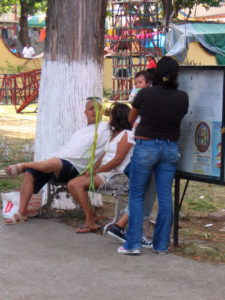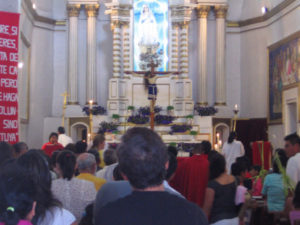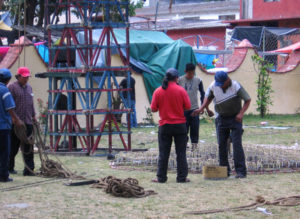What is at the heart of festivals in Mexico? Mexican festivals have something special that those of us non-Mexicans just have to experience to understand. Santa Maria Ahuacatilan, Morelos is the place to experience church centered community celebration. This little town just north of Cuernavaca is maintaining its festival traditions into the 21st century. For me the highlights of these celebrations are the castillos.
Castillos are temporary towers covered with fireworks, which light up in pre-planned succession displaying colored images, shooting golden sparks, spinning, and smoking before the crowd of onlookers. Every stage of the Castillo display brings out a sigh of delight as butterflies turn into swans, and Virgin Maries glow above text imploring her prayers.

Castillos are part of many different church celebrations throughout Mexico, but the ones in Santa Maria go far beyond the ordinary, with two or three towers, spinning crowns, and images that transform as they burn. They are so well done in there that we try to enjoy them all throughout the year with our family. I encourage you to visit Santa Maria during one of its many festivals (listed below).
Arriving in Santa Maria in the afternoon on the day that a castillo will be lit, you’ll find the streets bordering the churchyard full. The cobblestones turn your ankles slightly as you thread through the crowd past the mobile bread bakeries and their warm, sweet scents. The sales people offer you a piece of bread so you can tear off a chunk and try its tender, lightly sweetened flavor. You can buy two large loaves of nut bread sprinkled with sesame seeds for $25 pesos and, if you check around a bit, you can get some that are still warm from the oven. You will also pass potato chip sales carts and corn-on-the-cob stands where you can get your corn on a stick slathered with your choice of a combination of mayonnaise, cheese, and chili or salt and lemon. Further down the road, the mechanical rides for children fill the streets so much that you have to squeeze between them and the walls of the bordering houses.
In the churchyard of the Iglesia Santa Maria de la Asuncion, the Mexican cypress trees stand tall over the castillo assembly process. Men use a huge jack to stack cubes made of one-by-ones one on top of the other. As the tower grows upward, they assemble the various wire racks, mounted with hand-packed fireworks that will be the display.
You can spend the afternoon by enjoying mass, resting in the churchyard, playing on the rides, and eating the various treats being sold. At nine o’clock, it’s dark and it’s time join the loosely packed crowd in the church yard because the lights are turned out and the castillo is about to be lit. Choose a spot toward the back of the crowd for safety and be ready to be pleasantly surprised.
The castillo display was initiated by the sucking boom of a large firework being shot out of a launch tube to the left of the crowd. We flinched in surprise, then looked up to see a purple and golden plume blooming overhead while the crackle of fireworks filled the air. Next the middle tower of the castillo in front of us lit up showing a glowing peacock, spinning slowly on its mount. The show went on with a band playing on a stage visible over the churchyard wall, the fireworks alternating with the displays on the castillo until there was a grand finale of fountains of golden sparks raining down from all three castillo towers and multicolored fireworks booming and crackling overhead. We were squinting against the amount of acidic gunpowder smoke billowing around us, smiling, and keeping a weather eye out for hot cinders raining down over the crowd.
Every castillo display is different and worth seeing. You simply cannot imagine one until you’ve experienced it. I must warn you, though, that first you’ll think they are too dangerous to enjoy but after you’ve seen one of Santa Maria’s unique displays, 4th of July fireworks in the U.S. will pale in comparison. (Safety note: If you come to see a castillo in Santa Maria you should leave the church yard as soon as the castillo is over because another fun – but much more dangerous -tradition of running with firework-covered papier mache bulls follows immediately. You must be careful at the gate because the crowd packs into the gateway, pushing to avoid these flaming bulls.)
Naturally, it is the people of Santa Maria who make their castillos and all the rest of their celebrations special. To find out more about their elaborate system of festivals, I talked to Claudia Cruz Flores (approximately 25 years old) who has lived kitty corner to the churchyard in central Santa Maria all of her life and carries the traditions in her heart.
Claudia listed the following festivals: San Jose, 15 days before Palm Sunday; San Ramos, Palm Sunday; Virgen de los Dolores, Friday before Easter; Señor de la Caña Xoquitzingo, Easter Sunday; La Virgen de la Asuncion from August 1st to the 16th; Dia de la Santa Cruz, May 3rd; La Virgen de Guadalupe, May 10th; and there are more, but she couldn’t remember them off the top of her head. Her favorite festival is the one in August that celebrates La Virgin de la Asuncion, the patron saint of Santa Maria.
This festival is especially elaborate and fun. There are ongoing activities throughout the two weeks and culminate on the night of the 15th and the morning of the 16th. Claudia described how on the 14th of August, they lift the virgin down from her place above the altar to spend time with her for two days. At around 4 p.m., a group of people goes to the house where a new dress has been prepared for the virgin by community women. They dance and walk to the church carrying the new dress, accompanied by a band. At the church, a group of only women dresses the image in her new dress for the year, while the band plays for the virgin.
The band plays the song “Las Mañanitas” (“Little Mornings”), which is traditionally sung to people who are being celebrated, such as when it is someone’s birthday or to moms on Mother’s Day. (Click here for the original Spanish version and an English translation.) At 6 p.m., the church is closed and decorated with flowers so that it will be beautiful for the beloved image.
At midnight, everyone in town goes into the church and offers the virgin her first Mañanitas accompanied by a mariachi band. (That’s how Claudia says it; they don’t “sing to” the virgin, they “offer” her the song.) After the mariachis play, different local bands each take turns entering the church and all singing Mañanitas until two or three in the morning. Claudia has been part of a group that sings and plays musical instruments (called estudiantinas) for ten years. As part of “Resurrección,” Claudia sings to the virgin in the wee hours of the morning.
Claudia’s favorite things about all the celebrations throughout the year are the decorations in the church, which are made from natural flowers. For each festival, a particular house is selected to host the decorating. The young people are invited to come and help create the decorations three days in advance of the festival. They even go up to the pine forest and collect natural materials to be used in the arrangements. Working side by side, friends and family prepare the floral arrangements. Later, when they are placed in the church, Claudia likes to see the work of people she knows on display.
As you can guess, it’s not just the flower arrangements that are organized and prepared by members of the community. It’s every aspect of the festival. Each neighborhood is responsible for a different festival. Representatives of the neighborhoods who know the traditions go from house to house collecting donations to pay for the decorations, fireworks, castillos, and other items.
Many people also make personal pledges. For example, they may pledge 1,000 pesos (approximately $100 US dollars and more than a week’s salary for many people). They can pay their pledge amounts all at once just before the festival or they may pay it 100 pesos at a time throughout the year. If they don’t fulfill their pledge, then they have a sense of having failed their patron saint. This is part of an individual’s personal relationship with God. For the celebration for the town’s patron saint on the 15th of August, every family in town has to pay a pre-set amount. Claudia gave $150 pesos as an example. She says that not everyone chooses to give money, but that those that do participate respect their choice to decline.
The festivals in Santa Maria are also part of a broader community. Members of two communities a little further up the mountainside, Topilejo and Gualupita come to celebrate and bring pledges as well. They may bring cash or may ask what is needed at the church such as vases for flowers. The priest is responsible for allocating the money according to the parishioner’s requests. Santa Maria returns this favor by sending committees in support of the other villages during their festivals.
I asked Claudia about her memories of the festivals throughout her life. She told me that even though her house is only 50 meters from the corner of the churchyard, she got lost once when she was little. The crowd was so thick that she became separated from her family and couldn’t figure out how to get home. She remembers standing near the gate to the churchyard crying until her parents came back for her. Her memories as a teenager are of making decorations and bringing the virgin’s dress to the church on August 14th. She says that it was her grandparents, born and raised in Santa Maria, who got her and her siblings and cousins interested in participating in the festivals. They would invite them to attend masses and go to the preparations.
So, if you have a desire to travel to Mexico, come in August (or for Easter or in May), and see the celebrations in Santa Maria. You can stay in Cuernavaca because Santa Maria is only five minutes up the non-toll highway (called the libre) connecting Cuernavaca to Mexico City. It is so close to Cuernavaca that a really good option is to take the bus route number 12. The creativity, generosity, and enthusiasm of the people of Santa Maria are sure to touch your heart.
Published or Updated on: December 1, 2006

















